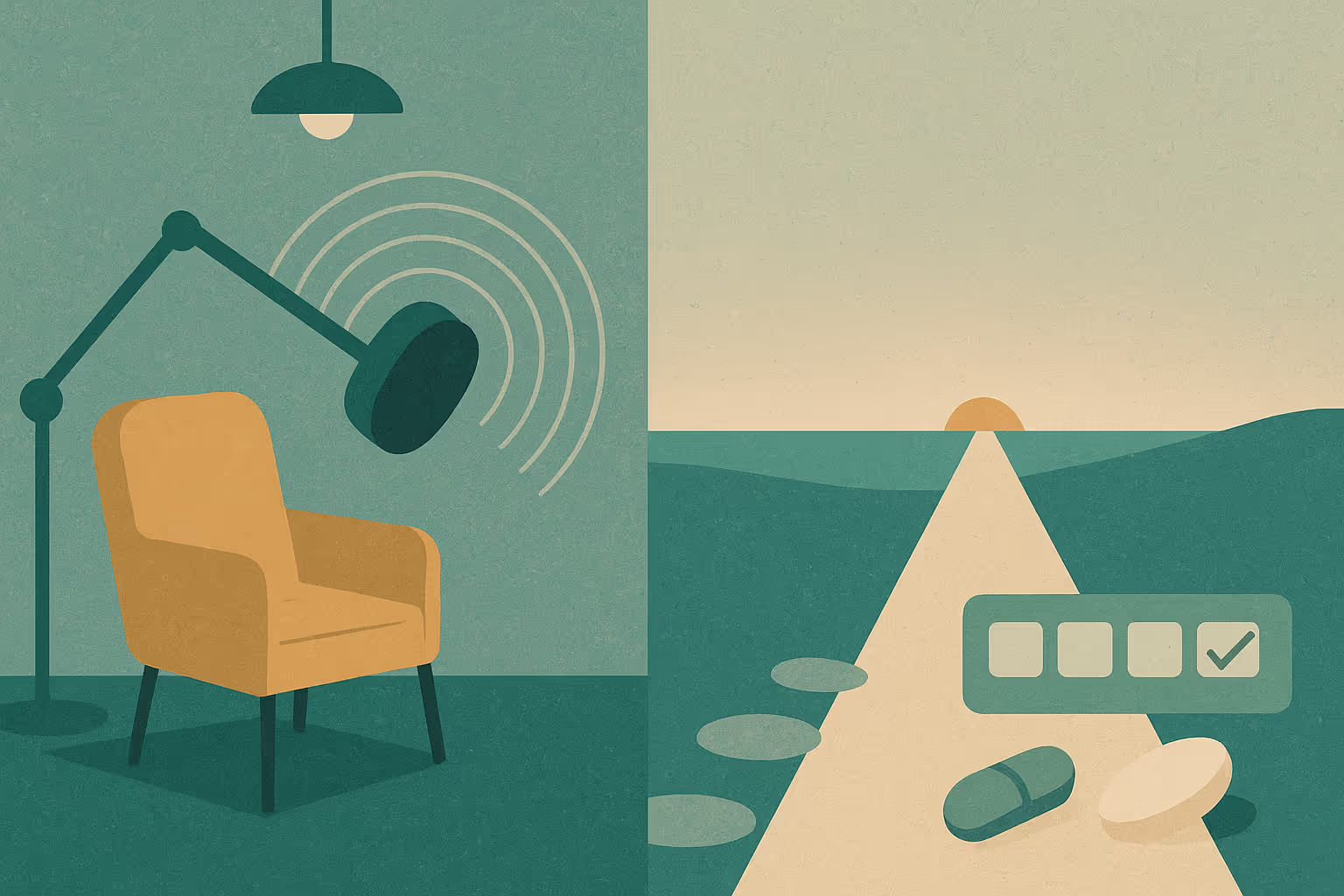Group Practices & Ketamine Treatment: Collaboration That Scales
“Communication is key. Being in touch with members of a group practice is of the highest priority. The treatments we provide are meant to be integrated into the framework of support a patient is already receiving. We prioritize partnership.”
— Benjamin Yudkoff, MD, Chief Medical Officer, Lumin Health
Group practices already understand complexity. You juggle multiple clinicians, diverse therapeutic approaches, constantly varying patient needs, and a shared chart. Adding ketamine therapy or esketamine (Spravato) to that landscape can seem overwhelming, but it doesn’t have to introduce confusion — it can strengthen the collaborative rhythm that defines your practice.
The key is not to reinvent your workflows, but to clarify them. As Dr. Yudkoff emphasized, the same principles that govern thoughtful collaboration in psychiatry and psychotherapy — trust, communication, and respect for the patient’s lived experience — are exactly the ones that make ketamine treatment safe and effective.
“Trust is one of the values that helps make the treatment safer. If a member of the care team doesn’t sufficiently trust the treatment, it might not be the right treatment for that patient — because that uncertainty can enter the patient’s experience.”
This guide offers a framework for group practices to integrate or coordinate with Spravato clinics and ketamine providers — maintaining clarity, predictability, and patient-centered safety across every clinician involved.
Shared Protocols, Documentation, and Handoffs
One-page referral and risk screen
The simplest way to align multiple clinicians is through a shared starting point. A tactic that can empower this is a one-page referral screen that allows any provider — psychiatrist, therapist, nurse practitioner, etc. — to quickly assess whether a patient might be appropriate for ketamine therapy or Spravato treatment.
A practical screening form might include:
- Primary diagnosis and treatment history: noting antidepressant trials, therapy engagement, and any partial responses.
- Medical readiness: blood pressure, cardiac history, pregnancy status, seizure risk.
- Psychiatric stability: excluding untreated mania or psychosis, clarifying recent suicidality.
- Medication review: benzodiazepine or stimulant use that could influence response.
- Support system check: confirmation of outpatient follow-up and safe transport post-dose.
This shared referral sheet ensures that anyone in your practice — front-line therapist or consulting psychiatrist — can begin the process confidently, with clarity about what’s needed next.
Update templates your team can reuse
One of Dr. Yudkoff’s most practical insights applies directly to how updates are managed in multi-clinician settings: communication needs to be structured, repeatable, and quick to interpret.
“It can be tricky to build the care team around the patient, especially as they mount improvement — or not. The same ideas that apply in individual practice extend into group practice: be mindful of the patient’s experience, and understand how the treatment fits your workflow.”
Group practices can create standardized update templates to embed in the EMR or shared inbox:
Example update fields:
- Evaluation result: eligible / not eligible / pending.
- Treatment route: Spravato (esketamine) / IV / IM / oral.
- Session count to date and general response trend.
- Observed side effects or dissociation intensity.
- Next dosing date and follow-up interval.
- Clinical contact for coordination.
This predictable cadence — an initial evaluation summary, a midpoint update, and a conclusion report — prevents the drift that can happen when one clinician assumes another has received the latest information.
Safety & escalation pathways
Clear escalation routes reduce anxiety for clinicians and patients alike. When group practices coordinate with a ketamine clinic, everyone should know who calls whom if concerns arise.
- If therapy staff notice destabilization (increased anxiety, agitation, emotional flooding): notify the supervising psychiatrist and the ketamine clinic the same day.
- If the ketamine team observes risk elevation (suicidality, poor sleep, emotional blunting): the outpatient psychiatrist or designated clinical lead should receive a direct call.
- If a patient misses sessions in either setting, a single point person (e.g., practice manager or care coordinator) tracks outreach and confirms safety.
Dr. Yudkoff’s framing of this partnership is instructive:
“We see ourselves in a consultative role — providing another service, just as if a provider recommended exercise and the patient went to a physical therapist.”
Lumin Health is designed to manage safety and clinical rigor in dosing, evaluation and observation; the group practice continues guiding meaning-making, medication, and integration.
Returning patients to in-house care
At the end of a ketamine therapy or Spravato treatment series, the patient’s primary therapeutic home should feel unchanged.
Dr. Yudkoff emphasized that Lumin’s partnerships always center the existing outpatient team:
“The outpatient providers remain at the helm.”
To close the loop:
- Lumin Health sends a completion summary, noting total ketamine doses, response trajectory, and suggested maintenance options.
- The group practice re-establishes session cadence or medication review within a week of the last dose.
- Maintenance care (booster sessions, follow-up therapy) is tracked jointly, ensuring the patient’s progress from ketamine therapy doesn’t slip between systems.
This shared re-entry plan communicates something deeper to patients — that their therapeutic home has not changed, even as their tools for healing have expanded.
Building Communication That Scales
Group practices already function as ecosystems. Adding ketamine therapy or Spravato treatment doesn’t have to disrupt that ecosystem — it can reinforce it.
Dr. Yudkoff’s guidance threads through every layer of this process: trust the treatment enough to stay curious, stay communicative, and stay centered on the patient’s lived experience.
“Be mindful of the patient’s experience. We recommend that you understand the treatment well enough to see how it fits into the standard workflow that’s being offered. To that end, Lumin Health would be grateful to be a resource & partner in creating that understanding. ”
When communication is structured and trust is mutual, even complex care — spread across multiple clinicians, modalities, and systems — feels seamless. And for the patient, that seamlessness is the safety.
Group Practices & Ketamine Treatment: Collaboration That Scales
Group practices thrive on communication — and that’s precisely what makes them well-suited to coordinate ketamine therapy and Spravato treatment with Lumin Health. Drawing from Dr. Ben Yudkoff’s guidance, this article is the bedrock of a scalable structure for multi-clinician teams: a shared referral screen, update templates, defined safety pathways, and clear transitions back to in-house care.
This is designed to be consistent with Lumin Health’s philosophy: outpatient providers remain at the helm, and structured collaboration makes advanced treatments feel not experimental, but integrated.







